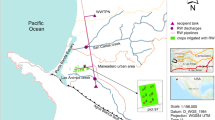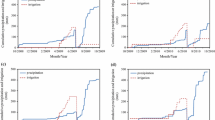Abstract
Subsurface drip irrigation is a sound method to apply sewage effluent, but there is a risk of nitrate and pathogen leaching. Field experiments were conducted during the maize growing seasons of 2014 and 2015 in the North China Plain to investigate the effects of lateral depth, irrigation level, and water quality on the deep percolation and the nitrate (NO3–N) and Escherichia coli (E. coli) leaching under semi-humid conditions. The experiments were designed with three lateral depths of 0 cm (D1), 15 cm (D2), and 30 cm (D3) beneath the soil surface along with three irrigation levels of 70% (I1), 100% (I2), and 130% (I3) of crop evapotranspiration requirements. Secondary sewage effluent and groundwater were used as irrigation water. The results indicated that the intensive rainfall caused most of the deep percolation and NO3–N leaching during the maize growing seasons. A high irrigation level usually produced more deep percolation and NO3–N leaching, but no significant difference was found among the treatments. In general, the cumulative NO3–N leaching beyond the root zone increased as lateral depth increased. In addition, the lateral depth obviously influenced the distribution of E. coli in soil, and subsurface drip irrigation usually induced E. coli contamination deeper in the soil. With relatively high nitrate and E. coli concentration, sewage effluent irrigation significantly increased the risk of NO3–N leaching beyond the root zone in the 2014 season, but imposed an insignificant influence on the presence of E. coli in soil. Furthermore, no E. coli was detected in the leachate following an irrigation event with sewage effluent or a rainfall event during the both maize growing seasons. A dripline depth of 15 cm with deficit irrigation can be conductive to reducing NO3 leaching as well as avoiding sewage effluent contact contamination during the maize growing season in the semi-humid region of the North China Plain.




Similar content being viewed by others
References
Ajdary K, Singh D, Singh AK, Khanna M (2007) Modelling of nitrogen leaching from experimental onion field under drip fertigation. Agric Water Manag 89(1):15–28. doi:10.1016/j.agwat.2006.12.014
Allen RG, Pereira LS, Raes D, Smith M (1998) Crop evapotranspiration-guidelines for computing crop water requirements. FAO Irrigation and Drainage, Rome
APHA, Awwa, WEF (1999) Standard methods for the examination of water and wastewater. American Public Health Association (APHA), Washington
Baram S, Couvreur V, Harter T, Read M, Brown PH, Hopmans JW, Smart DR (2016) Assessment of orchard N losses to groundwater with a vadose zone monitoring network. Agric Water Manag 172:83–95. doi:10.1016/j.agwat.2016.04.012
Blum J, Melfi AJ, Montes CR, Gomes TM (2013) Nitrogen and phosphorus leaching in a tropical brazilian soil cropped with sugarcane and irrigated with treated sewage effluent. Agric Water Manag 117:115–122. doi:10.1016/j.agwat.2012.11.010
Campos C, Oron G, Salgot M, Gillerman L, Casais G (2000) Attenuation of microorganisms in the soil during drip irrigation with waste stabilization pond effluent. Water Sci Technol 42(10–11):387–392
Chen W, Lu S, Jiao W, Wang M, Chang AC (2013) Reclaimed water: a safe irrigation water source? Environ Dev 8:74–83. doi:10.1016/j.envdev.2013.04.003
Choi C, Song I, Stine S, Pimentel J, Gerba C (2004) Role of irrigation and wastewater reuse: comparison of subsurface irrigation and furrow irrigation. Water Sci Technol 50(2):61–68
Darwish T, Atallah T, Hajhasan S, Chranek A (2003) Management of nitrogen by fertigation of potato in lebanon. Nutr Cycl Agroecosys 67(1):1–11. doi:10.1023/A:1025107202143
Duan R, Fedler CB, Sheppard CD (2010) Nitrogen leaching losses from a wastewater land application system. Water Environ Res 82(3):227–235. doi:10.2175/106143009x12487095236397
Engström E, Thunvik R, Kulabako R, Balfors B (2015) Water transport, retention, and survival of Escherichia coli in unsaturated porous media: a comprehensive review of processes, models, and factors. Crit Rev Env Sci Tec 45(1):1–100. doi:10.1080/10643389.2013.828363
Forslund A, Plauborg F, Andersen MN, Markussen B, Dalsgaard A (2011) Leaching of human pathogens in repacked soil lysimeters and contamination of potato tubers under subsurface drip irrigation in Denmark. Water Res 45(15):4367–4380. doi:10.1016/j.watres.2011.05.009
Forslund A, Ensink JH, Markussen B, Battilani A, Psarras G, Gola S, Sandei L, Fletcher T, Dalsgaard A (2012) Escherichia coli contamination and health aspects of soil and tomatoes (Solanum lycopersicum L.) subsurface drip irrigated with on-site treated domestic wastewater. Water Res 46(18):5917–5934. doi:10.1016/j.watres.2012.08.011
Gatica J, Cytryn E (2013) Impact of treated wastewater irrigation on antibiotic resistance in the soil microbiome. Environ Sci Pollut R 20(6):3529–3538. doi:10.1201/b18649-9
Gheysari M, Mirlatifi SM, Homaee M, Asadi ME, Hoogenboom G (2009) Nitrate leaching in a silage maize field under different irrigation and nitrogen fertilizer rates. Agric Water Manag 96(6):946–954. doi:10.1016/j.agwat.2009.01.005
Ghiberto P, Libardi P, Brito A, Trivelin PCO (2009) Leaching of nutrients from a sugarcane crop growing on an ultisol in Brazil. Agric Water Manag 96(10):1443–1448. doi:10.1016/j.agwat.2009.04.020
Halalsheh M, Ghunmi LA, Al-Alami N, Fayyad M (2008) Fate of pathogens in tomato plants and soil irrigated with secondary treated wastewater, efficient management of wastewater. Springer, Berlin
Hanson B, May D (2004) Effect of subsurface drip irrigation on processing tomato yield, water table depth, soil salinity, and profitability. Agric Water Manag 68(1):1–17. doi:10.1016/j.agwat.2004.03.003
Hassan G, Reneau RBJ, Hagedorn C, Saluta M (2005) Modeling water flow behavior where highly treated effluent is applied to soil at varying rates and dosing frequencies. Soil Sci 170(9):692–706. doi:10.1097/01.ss.0000185911.10836.07
Kouznetsov M, Pachepsky Y, Gillerman C, Gantzer C, Oron G (2004) Microbial transport in soil caused by surface and subsurface drip irrigation with treated wastewater. Int Agrophys 18(3):239–248
Lamm FR, Trooien TP, Manges HL, Sunderman HD (2001) Nitrogen fertilization for subsurface drip-irrigated corn. T ASAE 44(3):533. doi:10.13031/2013.6113
Lamm FR, Ayars JE, Nakayama FS (eds) (2007) Microirrigation for crop production-design, operation and management. Elsevier, Kidlington, 608 pp
Levy G, Fine P, Bar-Tal A (2011) Treated wastewater in agriculture: Use and impacts on the soil environments and crops. Wiley, Hoboken
Li J, Liu Y (2011) Water and nitrate distributions as affected by layered-textural soil and buried dripline depth under subsurface drip fertigation. Irrig Sci 29(6):469–478. doi:10.1007/s00271-010-0255-z
Li J, Wen J (2016) Effects of water managements on transport of E. coli in soil-plant system for drip irrigation applying secondary sewage effluent. Agric Water Manag 178:12–20. doi:10.1016/j.agwat.2016.08.036
Li J, Zhang J, Rao M (2004) Wetting patterns and nitrogen distributions as affected by fertigation strategies from a surface point source. Agric Water Manag 67(2):89–104. doi:10.1016/s0378-3774(04)00043-5
Lu R (1999) Chemical analysis methods of soils in agriculture. China Agriculture Science and Technology Press, Beijing (in Chinese)
Mack UD, Feger KH, Gong Y, Stahr K (2005) Soil water balance and nitrate leaching in winter wheat-summer maize double-cropping systems with different irrigation and N fertilization in the North China Plain. J Plant Untr Soil Sc 168(4):454–460. doi:10.1002/jpln.200520519
Milliken GA, Johnson DE (1989) Analysis of messy data, volume II: Nonreplicated experiments. Chapman and Hall/CRC, Boca Raton
Mmolawa K, Or D (2000) Root zone solute dynamics under drip irrigation: a review. Plant Soil 222(1–2):163–190
Mualem Y (1976) A new model for predicting the hydraulic conductivity of unsaturated porous media. Water Resour Res 12(3):513–522. doi:10.1029/wr012i003p00513
Oron G (1996) Soil as a complementary treatment component for simultaneous wastewater disposal and reuse. Water Sci Technol 34(11):243–252. doi:10.1016/s0273-1223(96)00844-x
Quemada M, Baranski M, Nobel-de Lange MNJ, Vallejo A, Cooper JM (2013) Meta-analysis of strategies to control nitrate leaching in irrigated agricultural systems and their effects on crop yield. Agr Ecosyst Environ 174:1–10. doi:10.1016/j.agee.2013.04.018
Santos LNS, Matsura EE, Gonçalves IZ, Barbosa EAA, Nazário AA, Tuta NF, Elaiuy MCL, Feitosa DRC, de Sousa ACM (2016) Water storage in the soil profile under subsurface drip irrigation: evaluating two installation depths of emitters and two water qualities. Agric Water Manag 170(31):91–98. doi:10.1016/j.agwat.2015.09.025
Schaap MG, Leij FJ, Van Genuchten MT (2001) Rosetta: a computer program for estimating soil hydraulic parameters with hierarchical pedotransfer functions. J Hydrol 251(3):163–176. doi:10.1016/s0022-1694(01)00466-8
Shirazi MA, Boersma L (1984) A unifying quantitative analysis of soil texture. Soil Sci Soc Am J 48(1):142–147. doi:10.2136/sssaj1984.03615995004800010026x
Van Donk SJ, Petersen JL, Davison DR (2013) Effect of amount and timing of subsurface drip irrigation on corn yield. Irrig Sci 31(4):599–609. doi:10.1007/s00271-012-0334-4
van Genuchten MT (1980) A closed-form equation for predicting the hydraulic conductivity of unsaturated soils. Soil Sci Soc Am J 44(5):892–898. doi:10.2136/sssaj1980.03615995004400050002x
Vergine P, Saliba R, Salerno C, Laera G, Berardi G, Pollice A (2015) Fate of the fecal indicator Escherichia coli in irrigation with partially treated wastewater. Water Res 85:66–73. doi:10.1016/j.watres.2015.08.001
Waddell JT, Gupta SC, Moncrief JF, Rosen CJ, Steele DD (2000) Irrigation and nitrogen management impacts on nitrate leaching under potato. J Environ Qual 29:251–261. doi:10.2134/jeq2000.00472425002900010032x
Wang Z, Li J, Li Y (2014a) Effects of drip irrigation system uniformity and nitrogen applied on deep percolation and nitrate leaching during growing seasons of spring maize in semi-humid region. Irrig Sci 32(3):221–236. doi:10.1007/s00271-013-0425-x
Wang Z, Li J, Li Y (2014b) Effects of drip system uniformity and nitrogen application rate on yield and nitrogen balance of spring maize in the North China Plain. Field Crops Res 159(15):10–20. doi:10.1016/j.fcr.2014.01.006
Wen J, Li J, Li Y (2016) Wetting patterns and bacterial distributions in different soils from a surface point source applying effluents with varying Escherichia coli concentrations. J Integr Agr 15(7):1625–1637. doi:10.1016/S2095-3119(15)61249-7
Zhou S, Wu Y, Wang Z, Lu L, Wang R (2008) The nitrate leached below maize root zone is available for deep-rooted wheat in winter wheat-summer maize rotation in the North China Plain. Environ Pollut 152(3):723–730. doi:10.1016/j.envpol.2007.06.047
Acknowledgements
This study was financially supported by the National Natural Science Foundation of China (Grant No. 51339007) and State Key Laboratory of Simulation and Regulation of Water Cycle in River Basin (Grant No. 2014ZY04).
Author information
Authors and Affiliations
Corresponding author
Additional information
Communicated by E. Fereres.
Rights and permissions
About this article
Cite this article
Qiu, Z., Li, J. & Zhao, W. Effects of lateral depth and irrigation level on nitrate and Escherichia coli leaching in the North China Plain for subsurface drip irrigation applying sewage effluent. Irrig Sci 35, 469–482 (2017). https://doi.org/10.1007/s00271-017-0553-9
Received:
Accepted:
Published:
Issue Date:
DOI: https://doi.org/10.1007/s00271-017-0553-9




